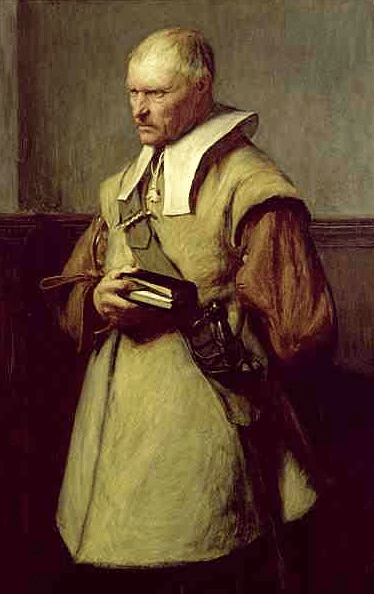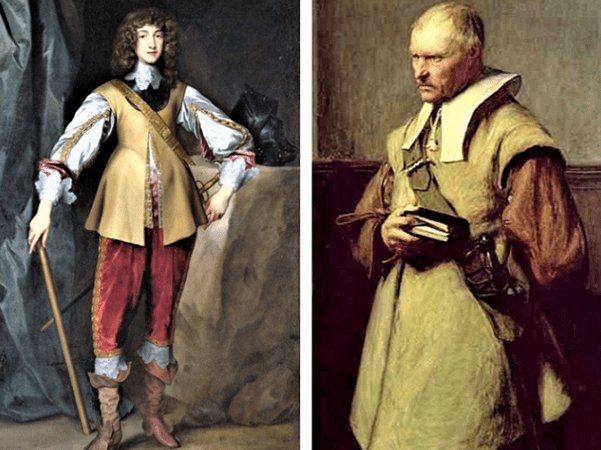Introduction: In this article, Melissa Davenport Berry describes how our Puritan ancestors did not approve of long hair – at least, the clergy and government officials didn’t. Melissa is a genealogist who has a website, americana-archives.com, and a Facebook group, New England Family Genealogy and History.
Earlier, I wrote about how residents in the Massachusetts Bay Colony (1628–1691) waged a war in the name of fashion. (See: Our Puritan Ancestors: Mass Bay Residents Waged a Fashion War in the Colony.)
Well, they did not stop with apparel: our Puritan ancestors also waged a fashion war against men’s long hair.

Back in the 17th century, head fashion became a hairy scene in the Massachusetts Bay Colony. For the Puritans, strict social order and convention were necessary for survival, and any individual expression and adornment was considered both a sin and a crime. Residents who focused on fancy dress and kinky hairdos were an enemy of the state. The magistrates launched an aggressive campaign on the matter, and several ministers wigged out in sermons using Biblical references to shame their flock for defying the law of God.
In 1634 the General Court ordered that no hair should lie over band or doublet collar. No proper Christian would want to look like a ruffian, varlet, or vagabond. A man with closely cropped hair was safe and godly.
Governor John Endicott of Massachusetts imposed legal pressure to submit to a balding lifestyle. The cropped man possessed good manners, and the long-haired were uncivil and enticed corruption. Those who did not cut in this civil frame would endure punishment.
Harvard College became an evil fortress regarding shaggy hair. The rule book for the first attendees clearly forbade anyone to wear long hair, locks, or foretops, or to use curling, crisping, parting, or powdering in their hair.
However, many lads were determined to keep their long locks at any cost. One of them, Ezekiel Rogers of Ipswich, would not trim his mane, so his uncle Rev. Ezekiel Rogers cut him out of his will.
An article published in the St. Louis Republic provided some background on this cropped hairstyle, which made a comeback in the early 1900s with America’s young men.
According to this article, the name “Roundhead” can be traced back to the reign of Charles I in England. During the Great Rebellion the Puritans, or friends of Parliament who denounced “unloveliness of locks,” were understood to distinguish themselves by having hair cropped off around their necks – while the opposition, the Cavaliers, wore long flowing ringlets.
“According to several records, the term of ‘Roundhead’ was first used in December, 1641, by a Captain David Hine, who, drawing his sword, swore he would ‘cut the throats of those round-headed, cropp’d-eared dogs that bawled against the Bishops.”
Anthony van Dyck, c. 1637. Credit: National Gallery, England; Wikimedia Commons.
Puritan mothers did not have the luxury to rush their little ones to the hair salon. A “home clip” was done by two methods. The first was the bowl method, where moms placed a bowl over the heads of their young hopefuls and trimmed all the hair that stuck out below the rim. The alternative method was to tie a rope around the head and clip all the hair below the rope.
Continuing my search in GenealogyBank’s Historical Newspaper Archives, I found another news clip in the San Francisco Bulletin which mentioned the many pamphlets published to encourage cropped hair. In Plymouth Colony, a manifesto called it an impious custom and a shameful practice for any man who had the least care of his soul to wear long hair.
The lovers of long locks created their own protest song:
“What creature’s this with his short hairs,
His little head, and huge long ears,
That this new faith hath founded?
The Puritans were never such,
The Saints themselves had ne’er so much –
Oh, such a knave’s a Roundhead.”
The wearing of wigs was sinful, and Chief Justice Samuel Sewall was in knots about it. An entry in his diary noted a visit to his cousin Josiah Willard, who had cut off all his hair to accommodate a wig. Willard preferred his artificial hair piece, but Sewall asserted that:
“God seems to have ordained our hair as a test to see whether we can bring our minds to be content to be at his finding.”
Willard promised to lose the wig when his own hair grew back.
In Sewall’s case, God chose to make him hairless. The Farmer and Mechanic reported that Sewall came head to head with his faith when he courted Madame Winthrop, who told him he needed a wig if he was to have any chance with her.
Sewall, too full of principle, parted ways with Madame Winthrop. He records in his diary that he could only be tempted to cover his head with a velvet cap to deliver him from the cold, and his maker would bring him the right dame.
Tune in next to see how the men of the cloth tried to control the ladies of the Massachusetts Bay Colony – who were overtaken by the Nell craze and ringlets!
Explore over 330 years of newspapers and historical records in GenealogyBank. Discover your family story! Start a 7-Day Free Trial
Further Reading:
- Sibley, John Langdon. “Sibley’s Harvard Graduates, Volume 2.” 1881, p.41
- Diary of Samuel Sewall: 1699-1714
- Berry, Melissa Davenport. “Hairstory Reveals Ipswich Flaunted Puritanical Power.” Ipswich Chronicle (Ipswich, Massachusetts), 2 May 2003, p. A9
Related Article:
